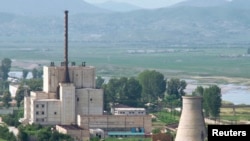North Korea has increased its efforts to produce parts for a new nuclear reactor it is building while continuing to operate the main existing one that provides fuel for its atom bombs, the U.N. nuclear watchdog said in an annual report released Friday.
North Korea has conducted two nuclear tests and dozens of missile tests since the beginning of last year, defying world powers and raising fears of a conflict breaking out on the heavily militarized Korean Peninsula.
A missile test last month put the U.S. mainland in range. Pyongyang later said it had a plan to fire missiles at the U.S. Pacific territory of Guam, while U.S. President Donald Trump said any threats would be met with "fire and fury."
U.S. Ambassador to the United Nations Nikki Haley said Friday, "It's a concern. It shows that North Korea hasn't backed down, they haven't stopped what they are doing and it is the reason why we continue to have our guard up when it comes to North Korea."
It is not clear whether Pyongyang can miniaturize a nuclear bomb enough to fit it on top of such a missile, and it is widely believed it cannot yet protect such a warhead from the heat generated when a missile re-enters Earth's atmosphere.
Its effort to produce material for nuclear bombs, however, has rumbled on, the International Atomic Energy Agency (IAEA) said in a report to its annual general conference. The IAEA does not have access to North Korea and monitors its activities mainly by satellite imagery.
Signs of making parts
"There were indications in the LWR [light-water reactor] construction yard of an increase in activities consistent with the fabrication of certain reactor components," the IAEA report posted on the General Conference's website said.
"The agency has not observed indications of the delivery or introduction of major reactor components into the reactor containment building," it said. The new reactor is expected to be larger than the current experimental one at Yongbyon.
There was no indication in the past year, however, that the communist state had used the laboratory near its main reactor where it usually produces plutonium from spent fuel rods, the IAEA said. That appeared to contradict a recent report by a U.S. think tank that said the lab had operated intermittently.
There were indications the experimental reactor had kept running, the IAEA said. Its previous report said the reactor had been refueled in 2015 and those fuel rods would probably be removed two years later. Friday's report confirmed that prediction, saying this fuel cycle should last until late 2017.
Even less is known about North Korea's efforts to produce another material that can fuel nuclear weapons — highly enriched uranium — but the report suggested those had continued at Yongbyon.
"There were indications consistent with the use of the reported centrifuge enrichment facility located within the plant. Construction work was undertaken on a building which adjoins the reported centrifuge enrichment facility," it said.










